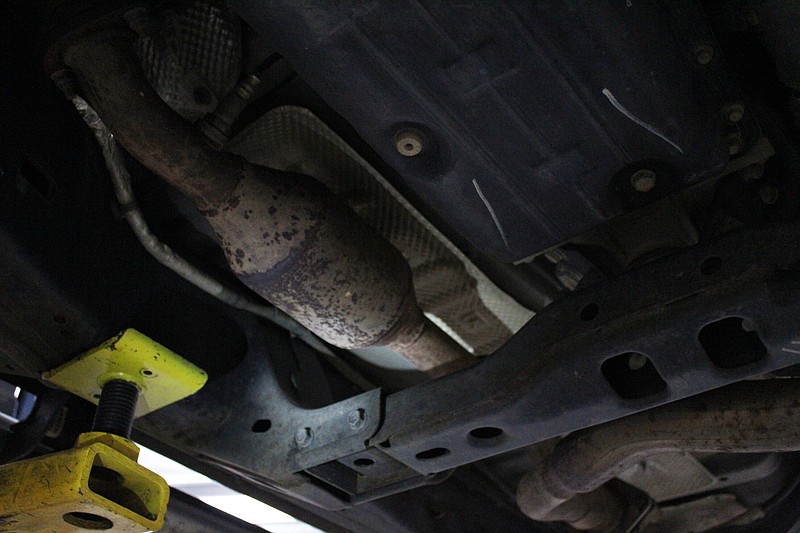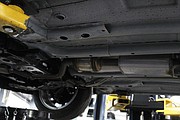Under a 2021 law aimed at curbing the theft of catalytic converters, the number of such crimes in the city has fallen but remains higher than Chattanooga Police Department officials would like.
“There is no way that we have come up with that we can prevent this from happening,” Chattanooga police investigator Nick Hayes said in a Tuesday interview. “They’re still going to get what they want to get … they’re going to where they know they’re not going to get questioned, (to) people that they’ve dealt with for a very long time, and they’re just taking the converters and paying cash.”
Hayes has been working on catalytic converter thefts for more than four years and has been monitoring the highs and lows of the market.
“The price of metal is what drives the price of the converters,” Hayes said.
If the market is high, both the price of metal and converter thefts are up, the investigator said. Hayes added that it only takes about 60 to 90 seconds to cut a converter off a vehicle.
Catalytic converters are an exhaust emission control device that converts toxic gases and pollutants in the exhaust into less toxic pollutants. The catalyst is made of mostly a mix of precious metals from the platinum group such as palladium and rhodium.
As of Friday, palladium was valued at $1,914 per ounce, 18% higher than gold, which is valued at $1,690 per ounce, according to Apmex, a precious metal investment website. Apmex also listed the value of platinum at $984 per ounce and silver at $21 per ounce.
Besides being used in catalytic converters, palladium can be used for jewelry and in some dentistry procedures, such as fillings and crowns, according to the Royal Society of Chemistry’s website. The website also said palladium is used as part of ceramic capacitors found in laptops and mobile phones.
The Police Department reported to the Chattanooga Times Free Press that there have been 575 catalytic converter thefts for 2022 thus far, compared to 683 for the same time period in 2021.
“That’s about a 16% decrease, although the overall numbers have remained high,” Sydney Hamon, a spokeswoman for the department, said by email.
Theft of catalytic converters is a nationwide issue, according to a 2021 report from published by State Farm. Theft of catalytic converters spiked during 2019, with California in the lead of reported thefts, followed by Texas, Minnesota, Washington and Illinois — based on data compiled from claims to repair or replace the piece made to the insurance company — with the thefts continuing to be high throughout the United States since.
The increase in those thefts prompted several states to pass laws to regulate and monitor the purchase and sale of catalytic converters. Tennessee passed a law aimed at regulating the purchase made by scrapyard proprietors of those pieces.
According to the Tennessee law, “Any person engaged in the business of buying or selling unattached catalytic converters as a single item and not as part of a scrapped motor vehicle shall give a written notification to the chief of police and sheriff of each city and county in which the activity is carried on.”
The law adds that “any person purchasing a used, detached catalytic converter must be registered as a scrap metal dealer.”
The law also states that dealers must verify and maintain documentation that would identify each piece purchased. Violation of the law is punishable by a $500 fine.
“The law changing … I didn’t see a decline. They weren’t doing it legally to begin with, so they didn’t have to change anything on their end once the law changed,” Hayes said. “It actually provided them a means to do it legally.
“If they know the right people, and they know where to take it, they can make over $1,000 per converter,” Hayes said. “I would say anywhere between $300 to $1,000 per converter, depending on the market.”
Hayes said efforts in apprehending catalytic converter thieves include obtaining surveillance video, looking at places thieves might be selling the converters, looking at pawn shops and keeping an eye on the scrap licenses issued by the state “to make sure that everything is being followed legally.”
While obtaining a catalytic converter by sawing it off a vehicle is illegal, once it gets into a thief’s scrapyard dealer’s hands, if the dealer has a scrap license through the state, it makes it legal, Hayes said.
“If they have that scrap license, it is hard for us to say, ‘That’s a stolen converter’ and press charges on it. It slows down the investigative process a little more, because we have to have more to press charges on them,” Hayes said.
Catalytic converters cannot be traced back to a specific vehicle because there is no identifying number on them. They can, however, be traced to a make and model, according to Hayes.
Hayes also said some people are marking them with spray paint to be able to identify the piece should it be stolen and sold in a scrapyard.
Aaron Smith, owner of the S&S Auto Repair shops in Hixson and Chattanooga, said in an interview that most efforts to identify the converters can be wasteful, with stickers melting with the excess heat created by the piece and that scratching or branding them can damage the catalytic converters, causing them to not do what they’re designed to do: filter toxins out of the vehicle’s exhaust.
“The reality is that there is no way that is safe for the consumer,” Smith said about placing an identifier on the piece. “The best way is for the consumer to have the manufacturer to put a VIN (vehicle identification number) on it that goes to your car.”
Smith said manufacturers outsource the making of those pieces, and it would make it difficult to add an identification number to each piece they outsource.
As thefts are consistently reported to be in the triple digits, Hayes said the entire city is being affected.
“There is no one place that is getting hit more than another,” Hayes said. “Obviously, anything that you can do to put your car in a well-lit area, in a populated area, is going to help, because the more people walk around, the more they’re going to get noticed and the less they’re going to want to get under a car … but because it’s so quick, if they want that converter, they’re going to get it.”
Contact La Shawn Pagán at lpagan@timesfreepress.com or 423-757-6476. Follow her on Twitter @LaShawnPagan.

